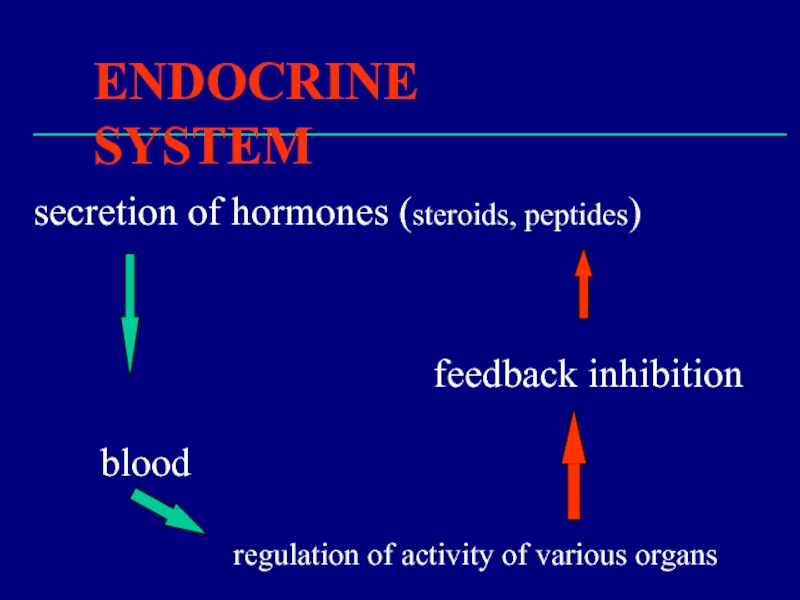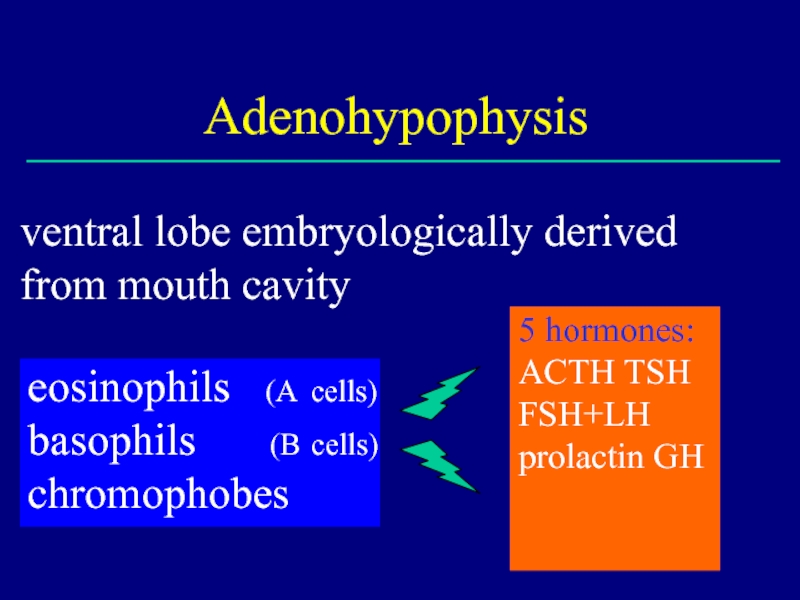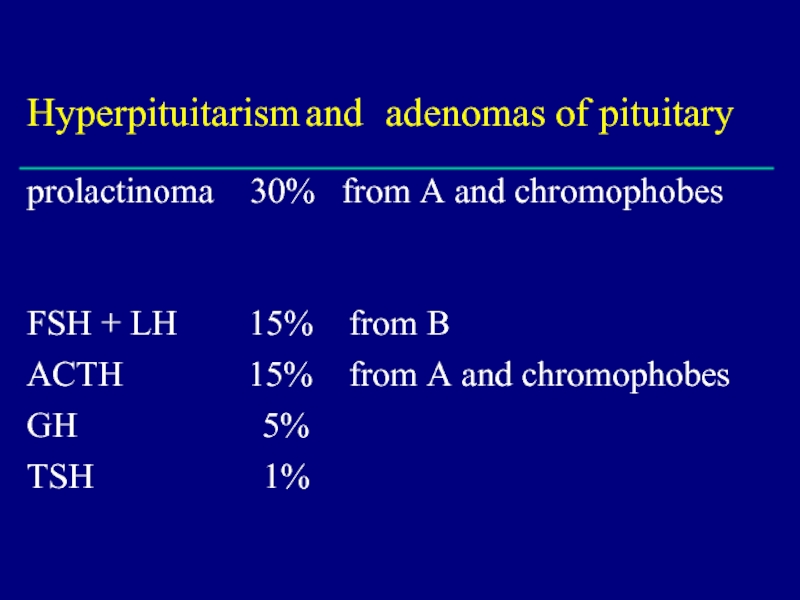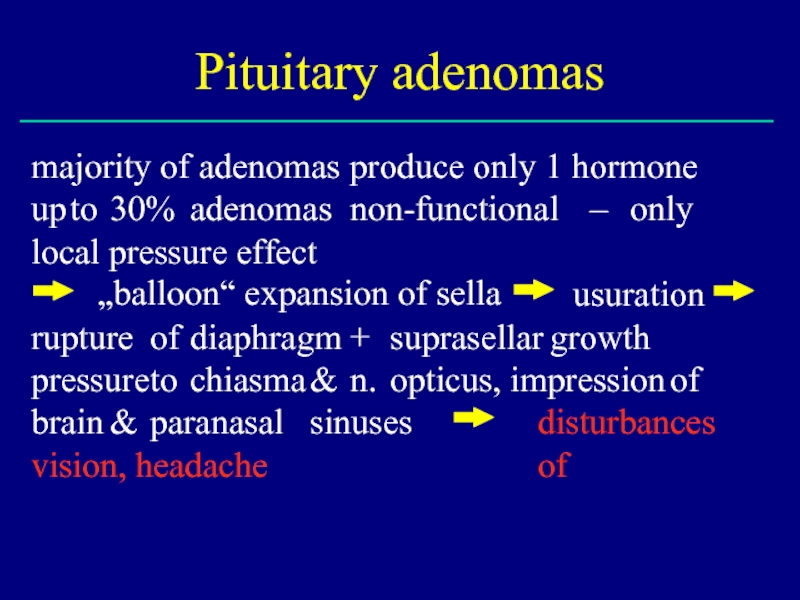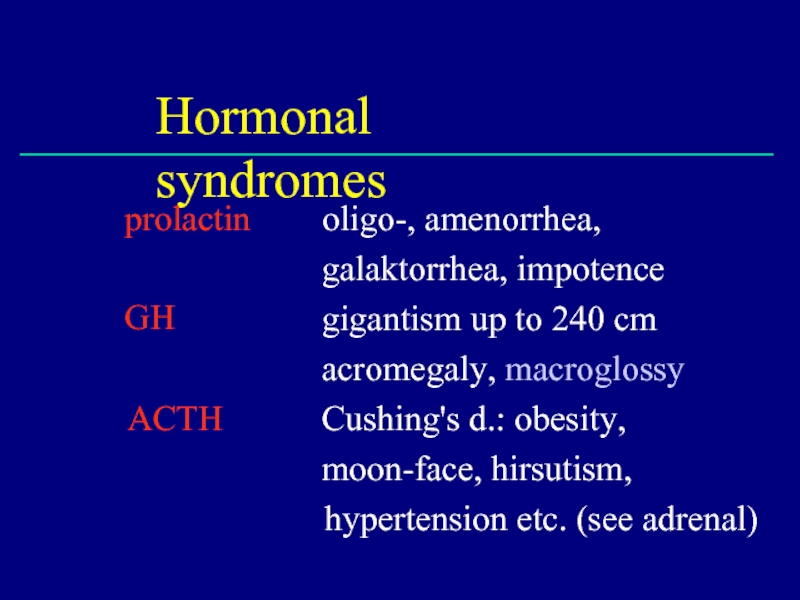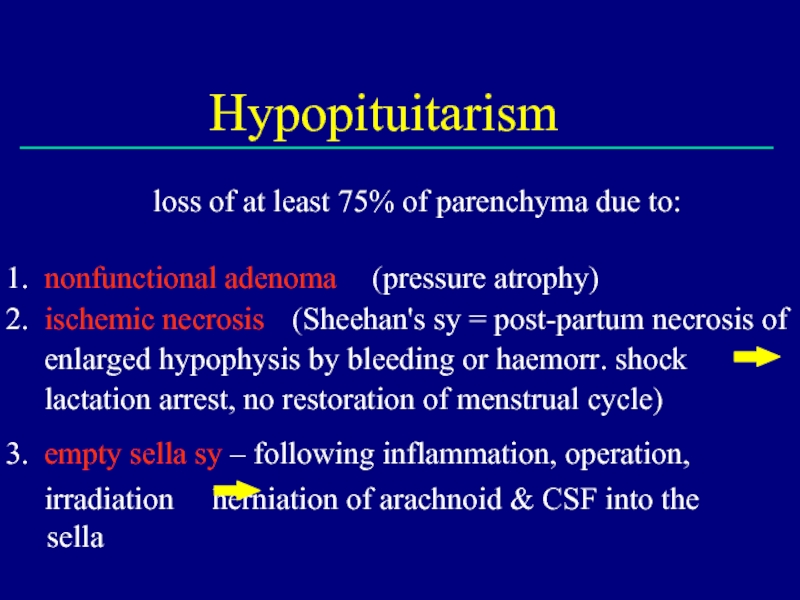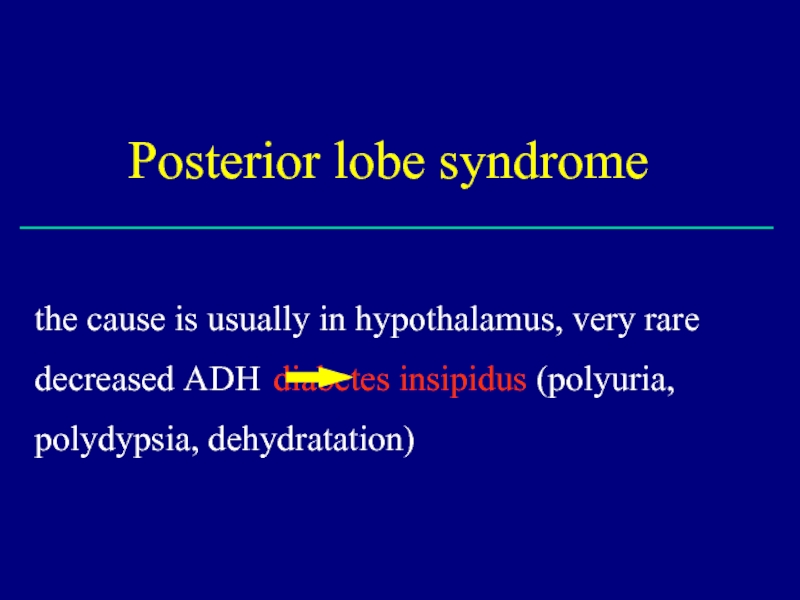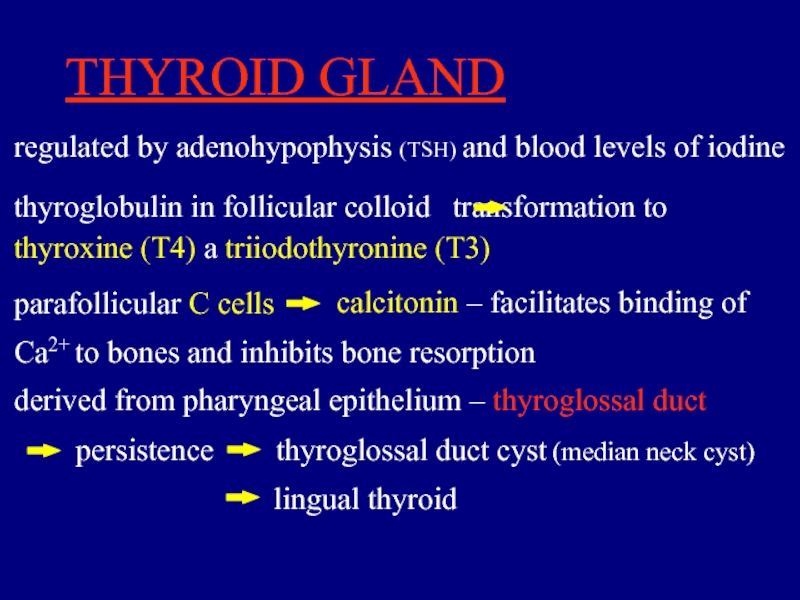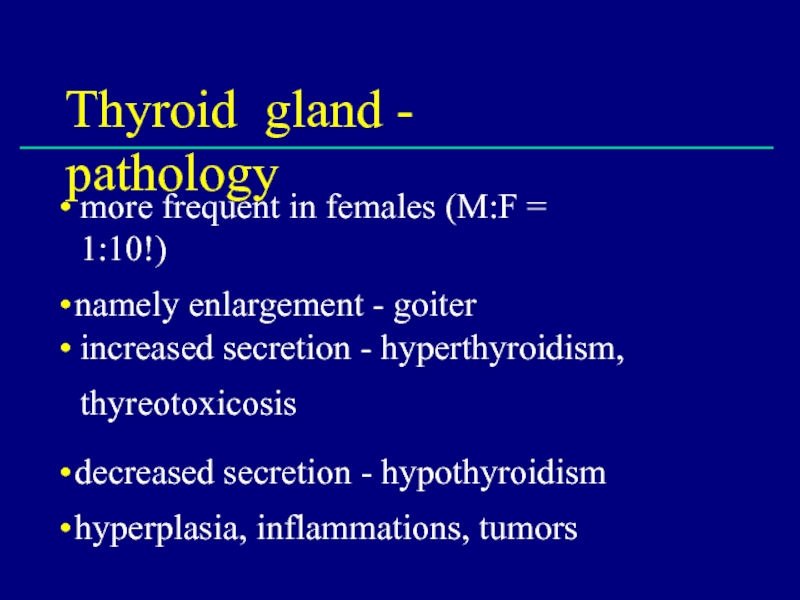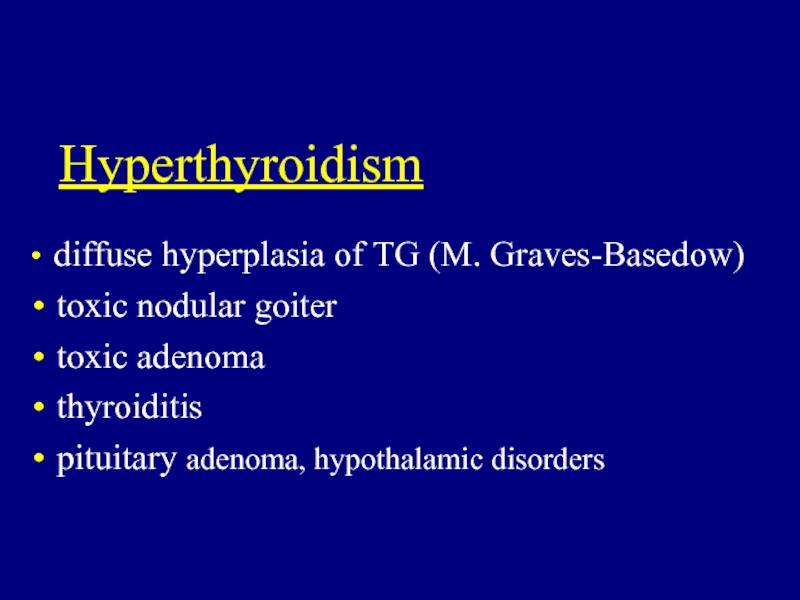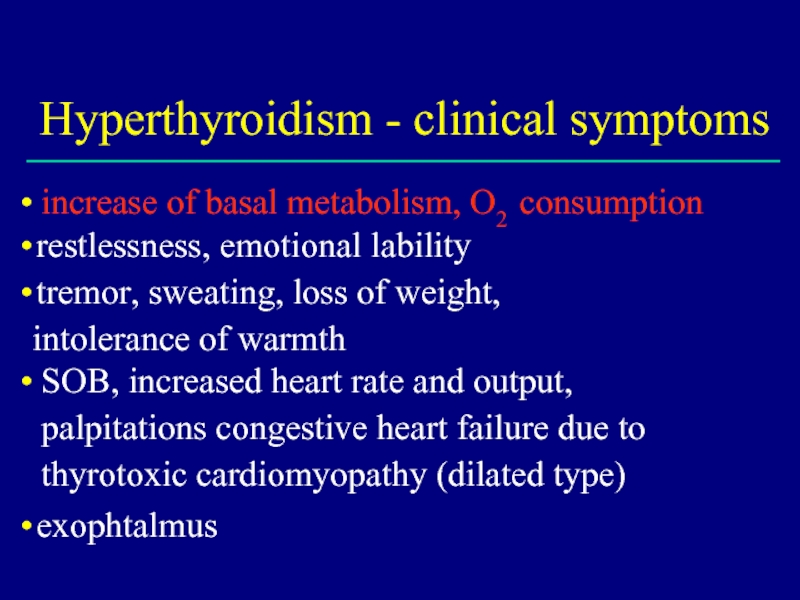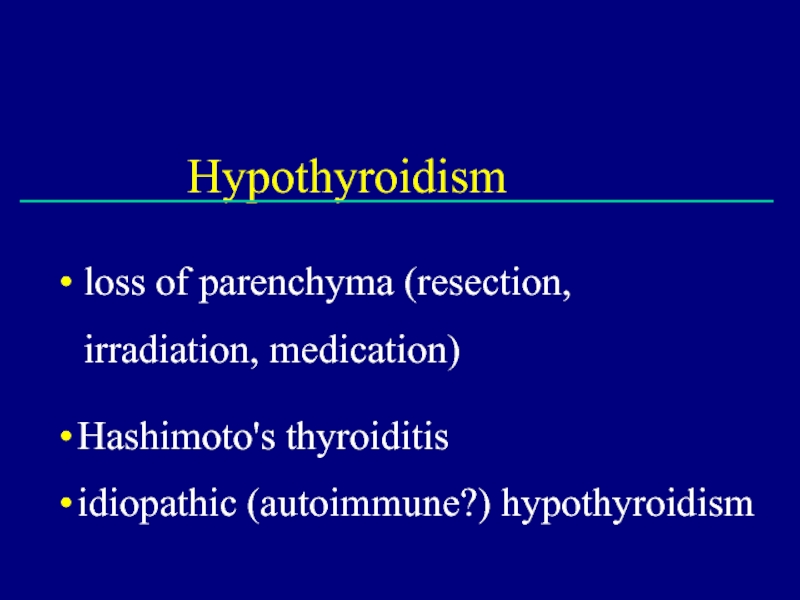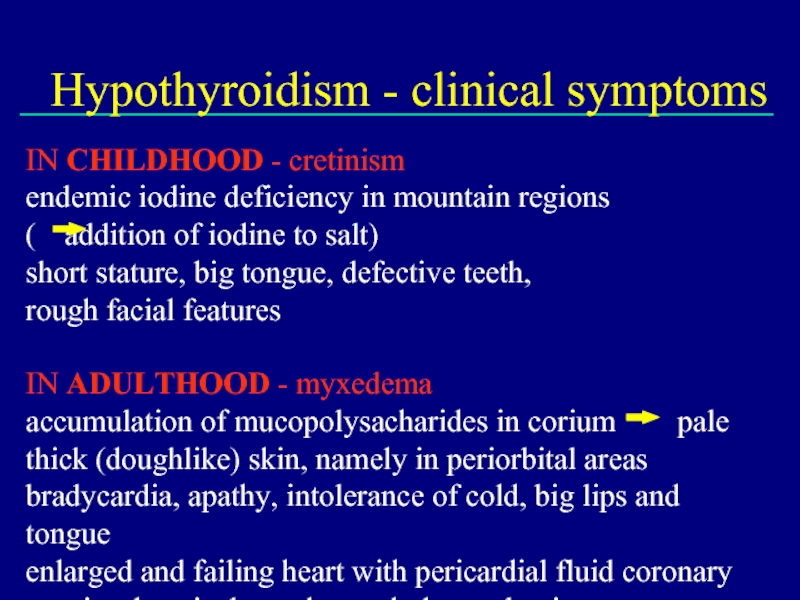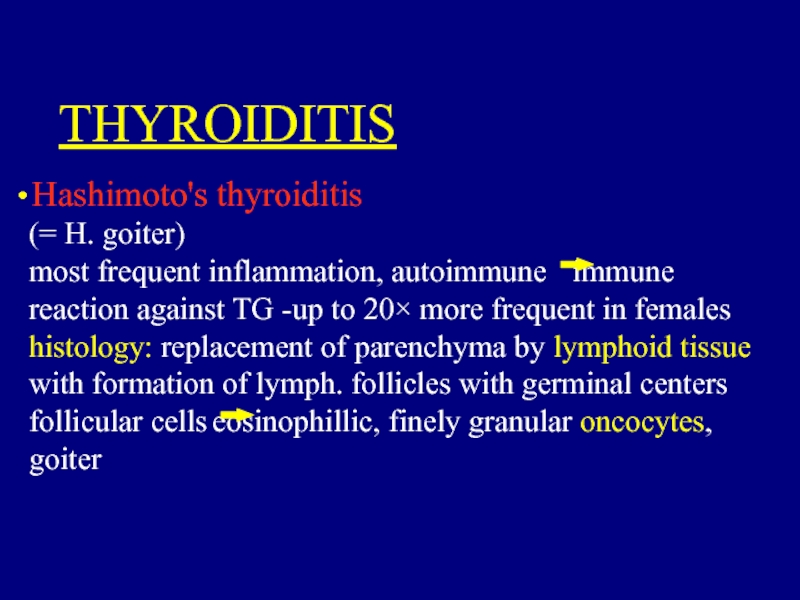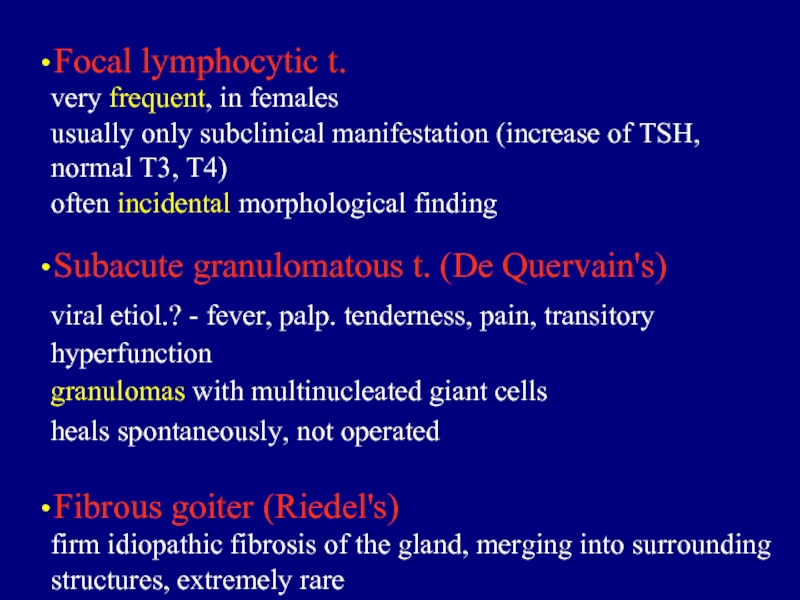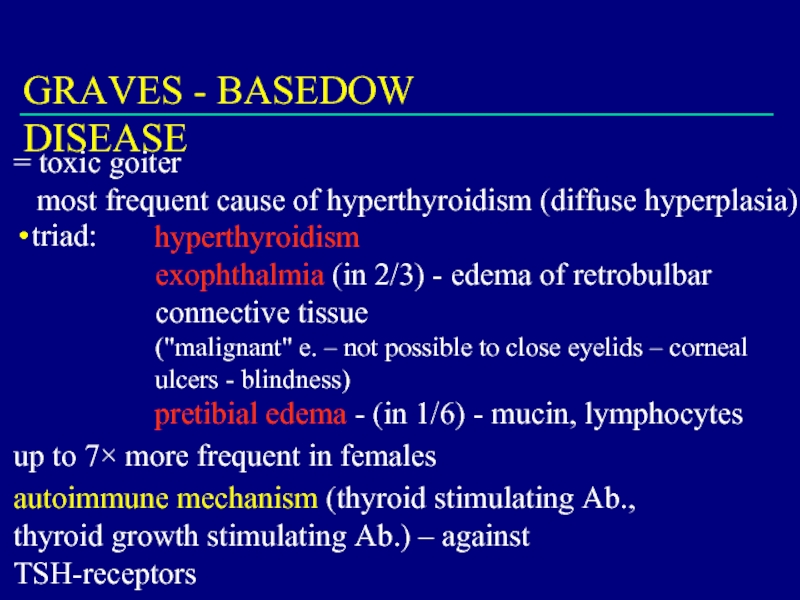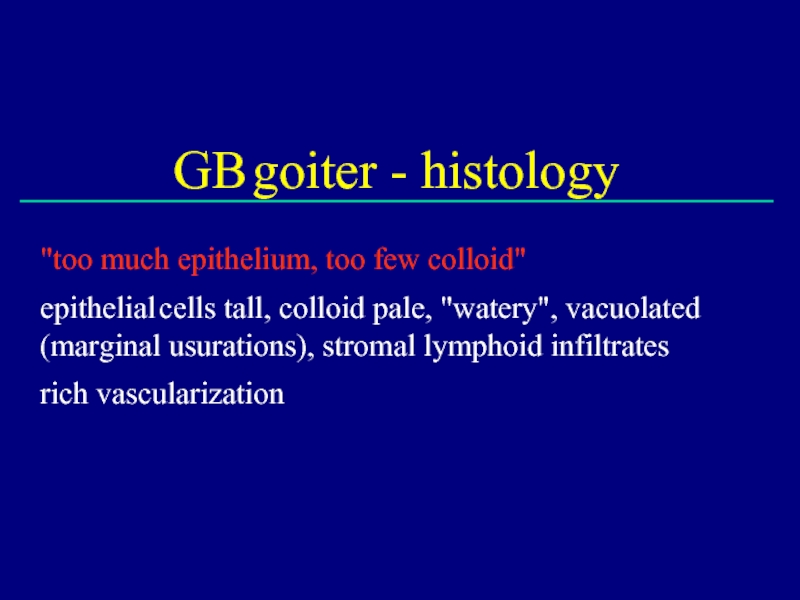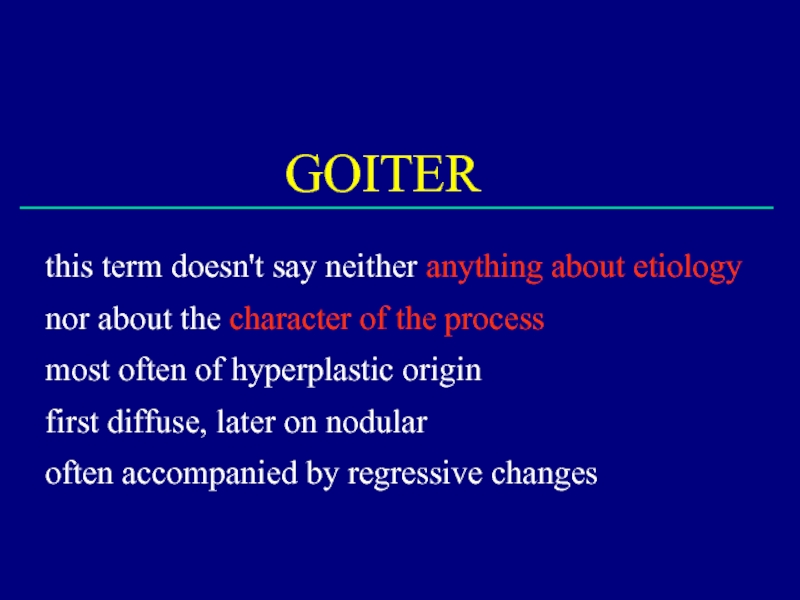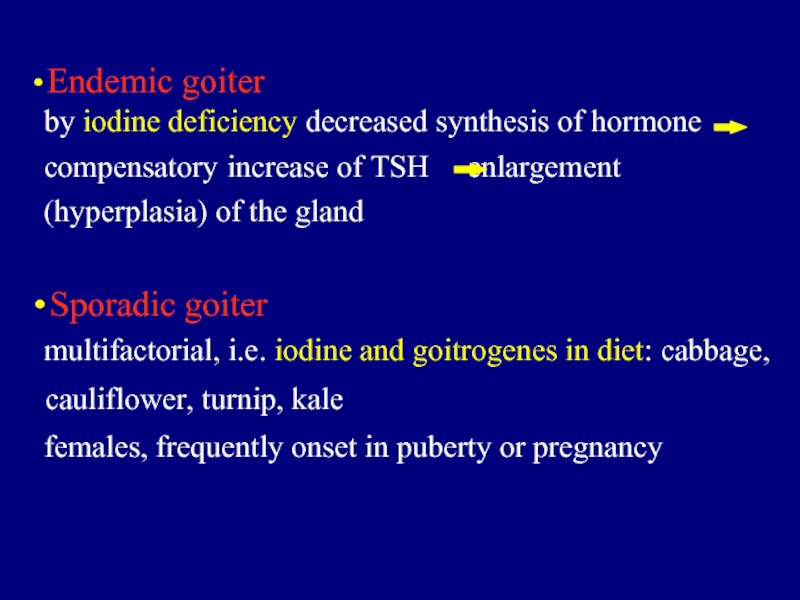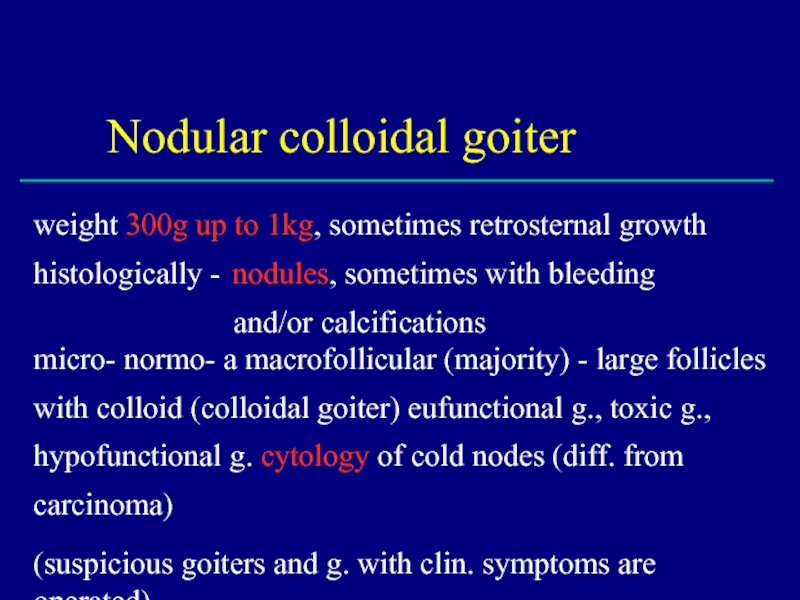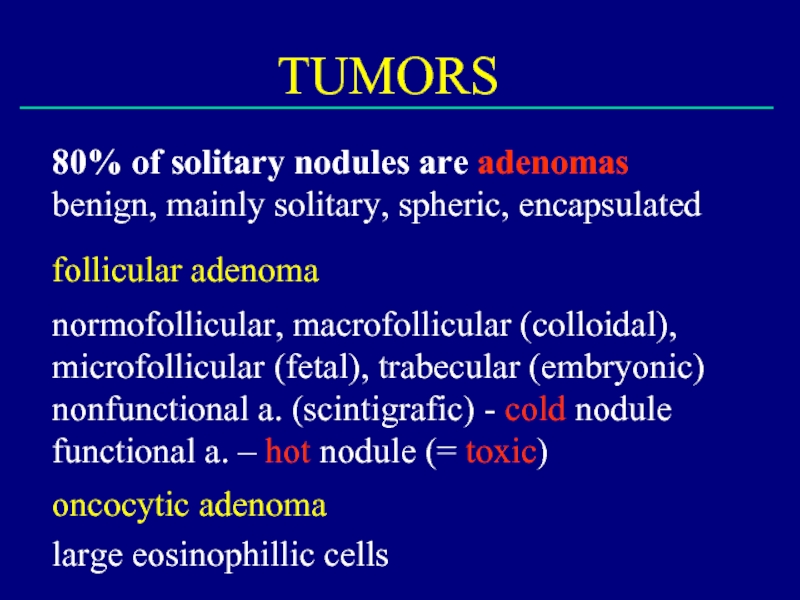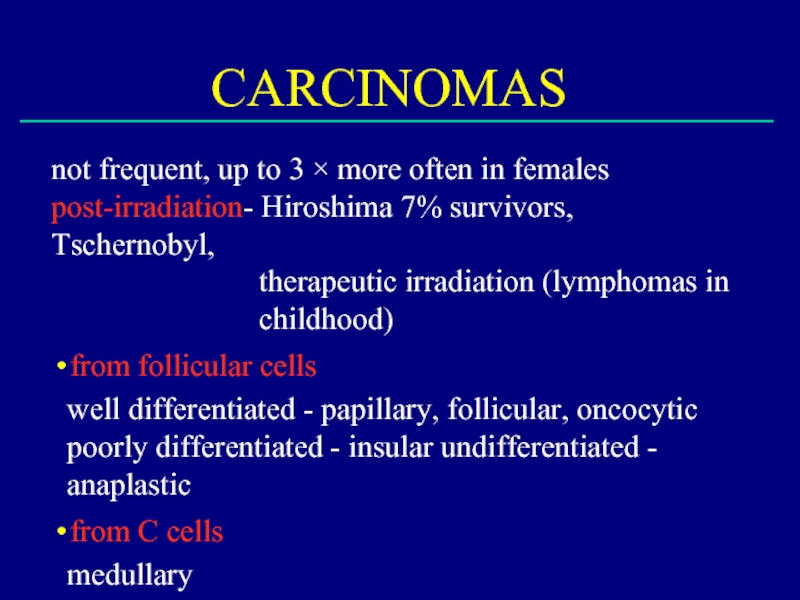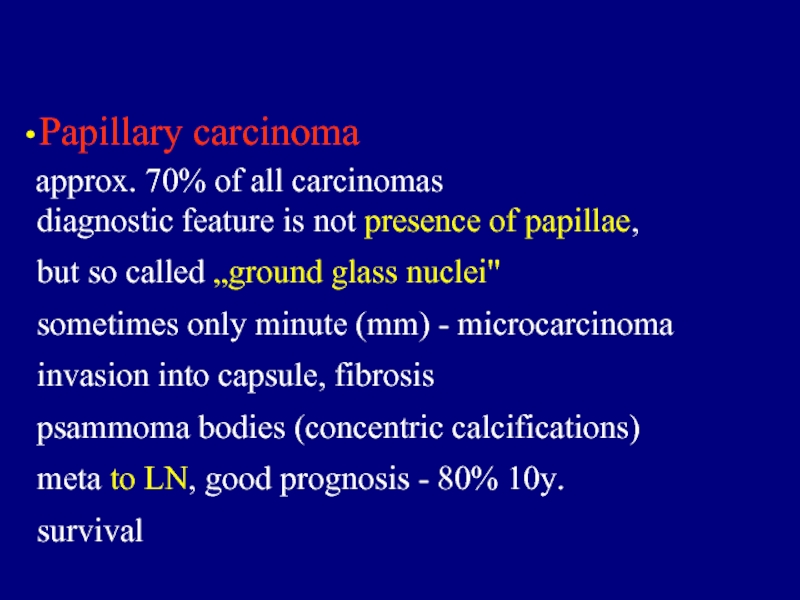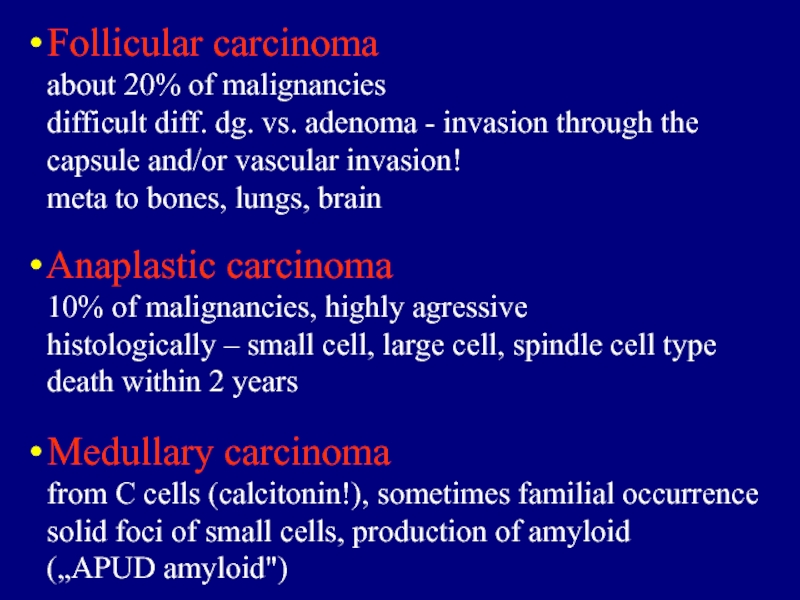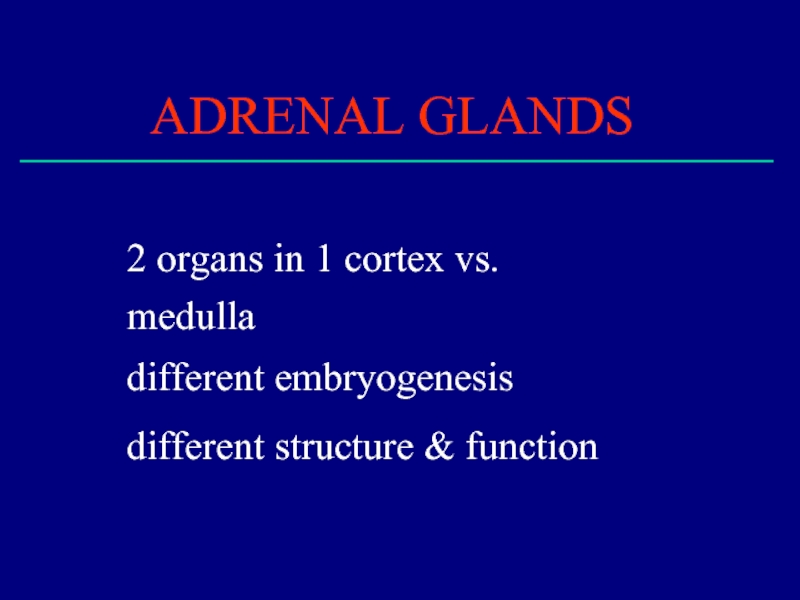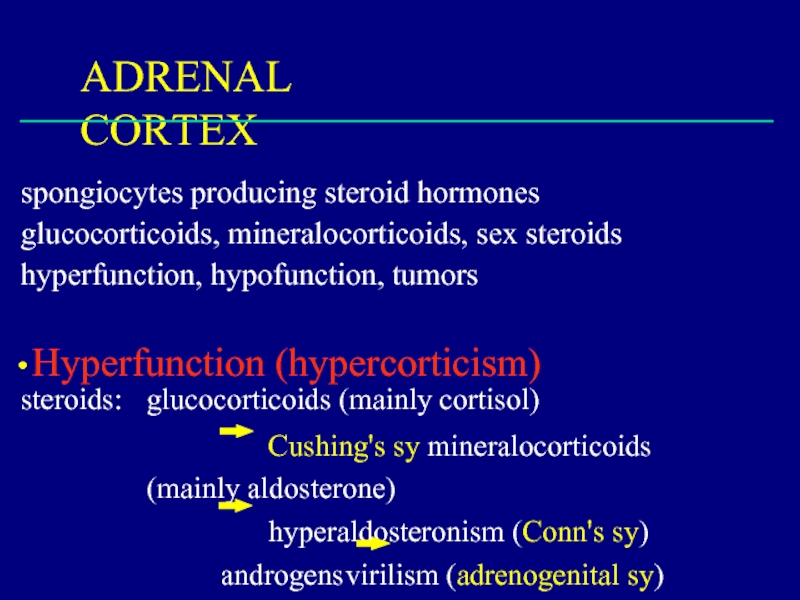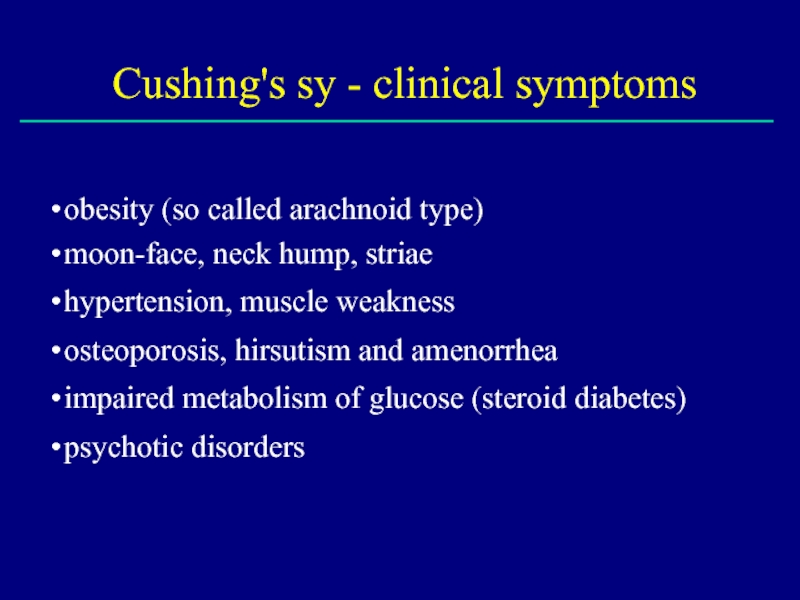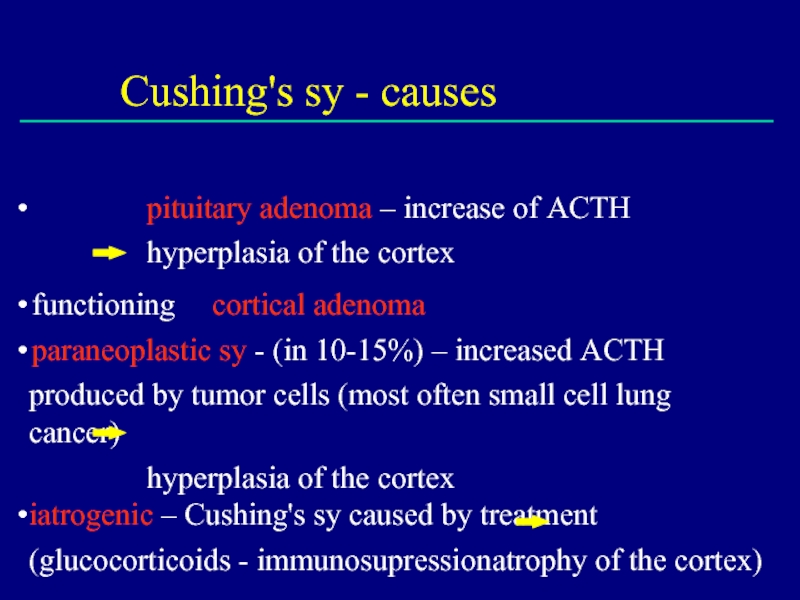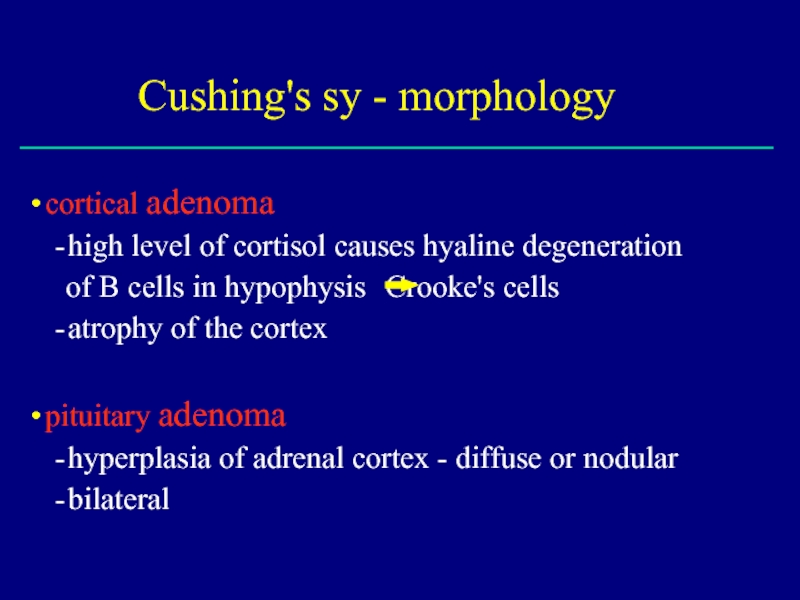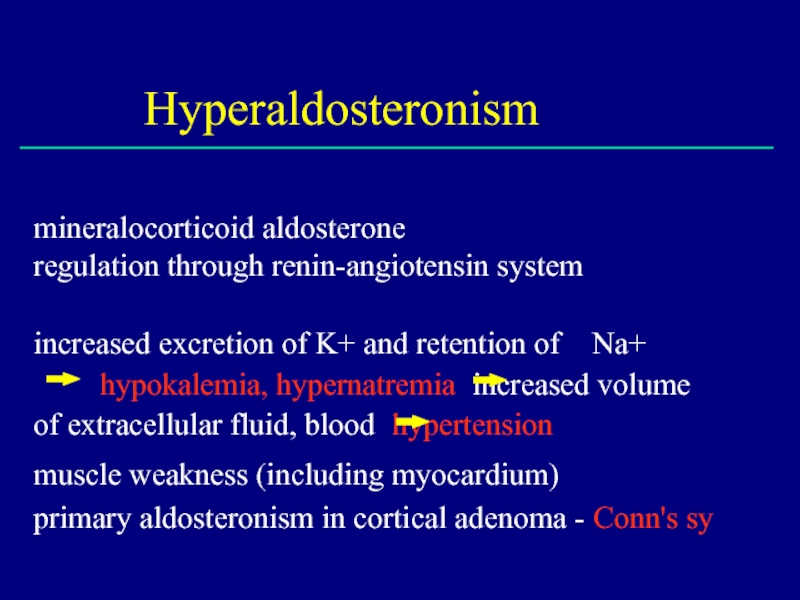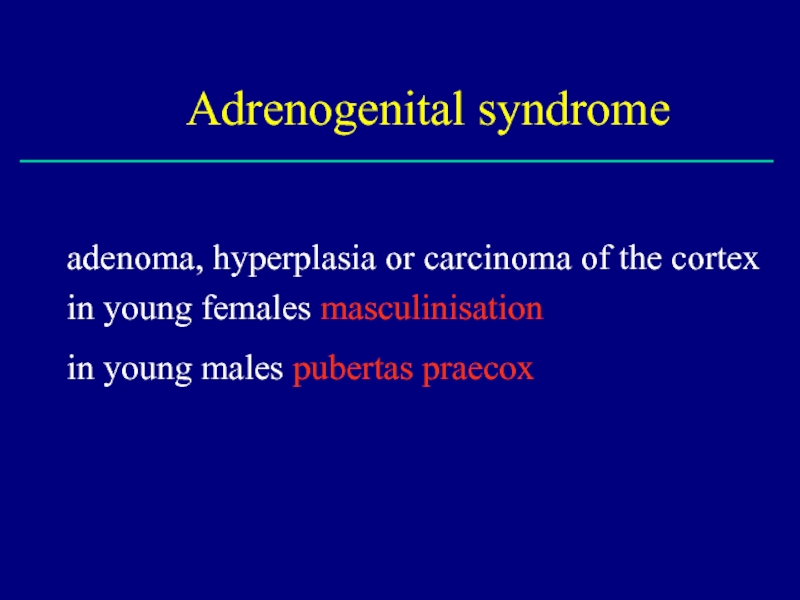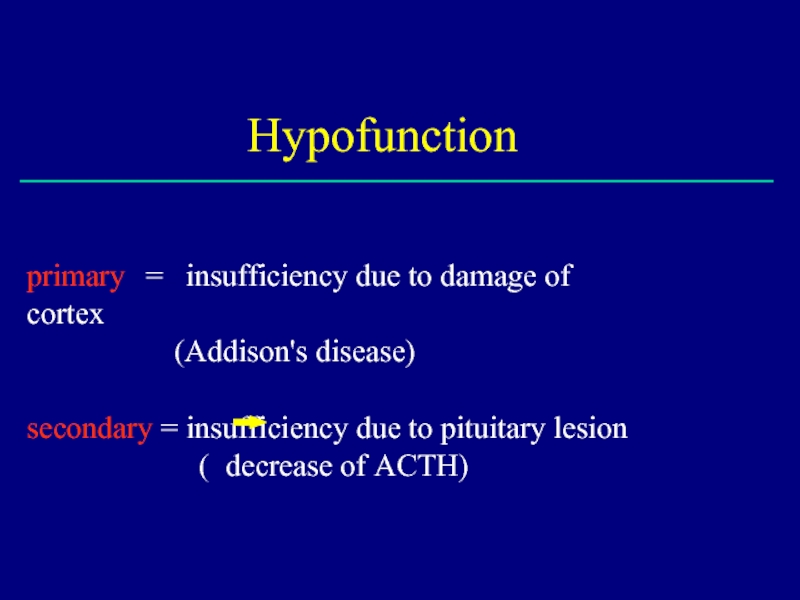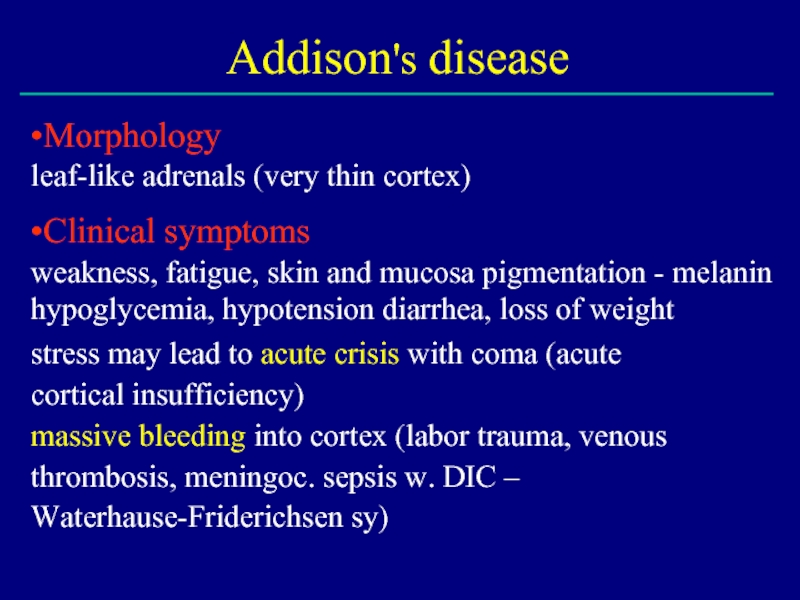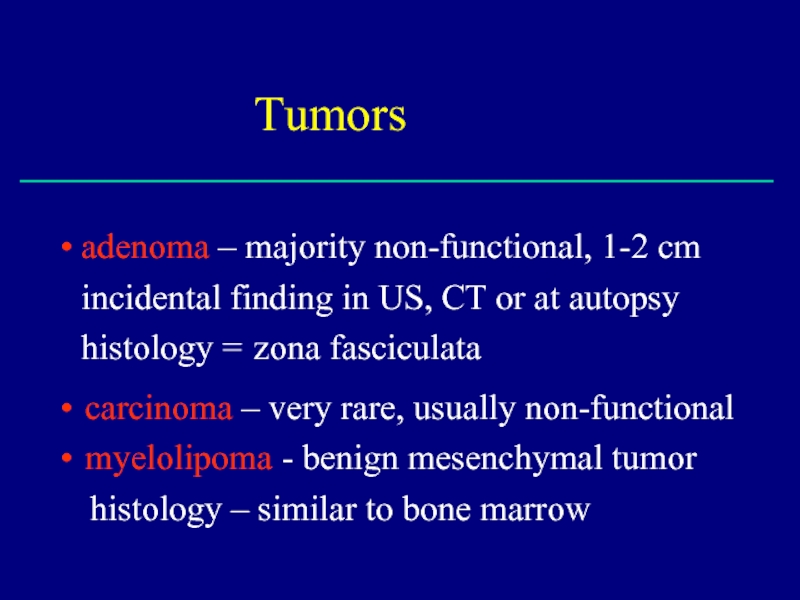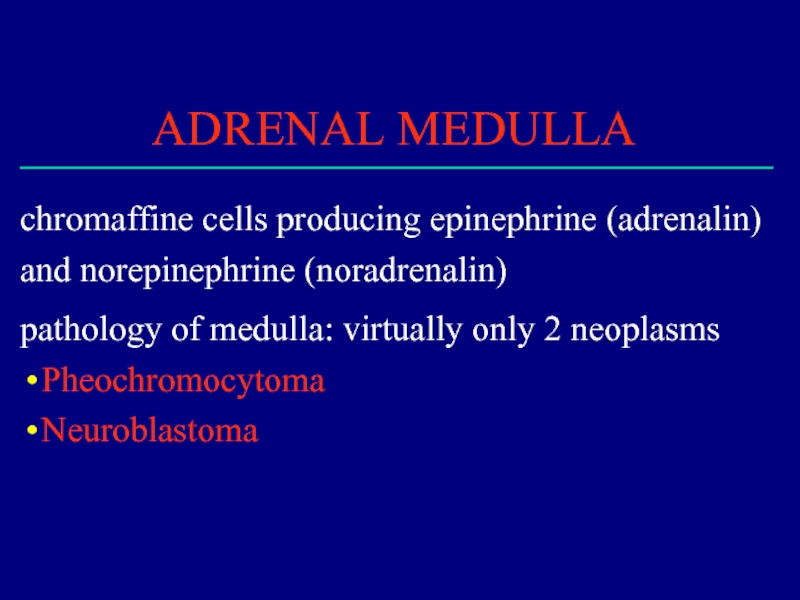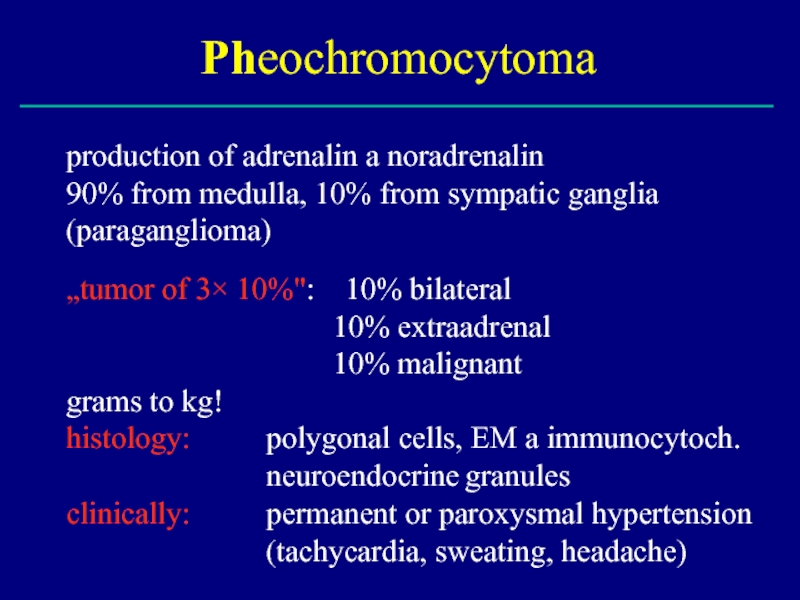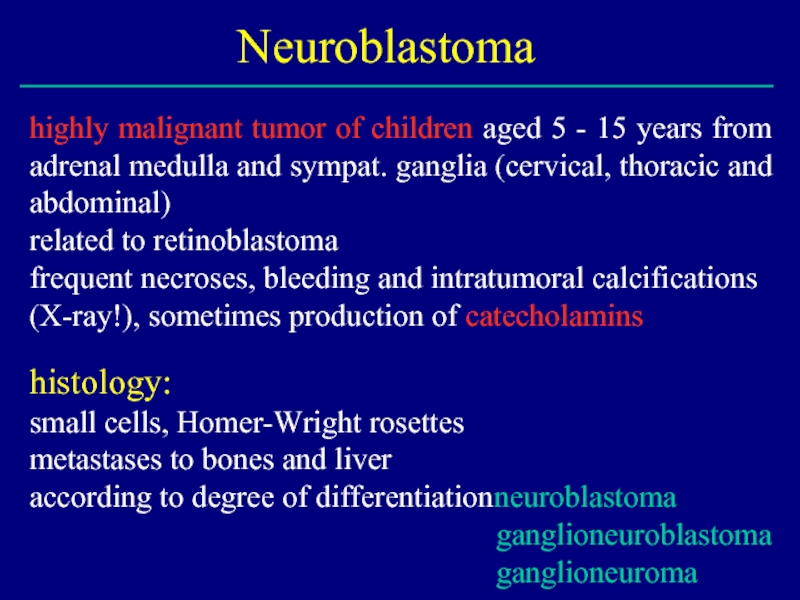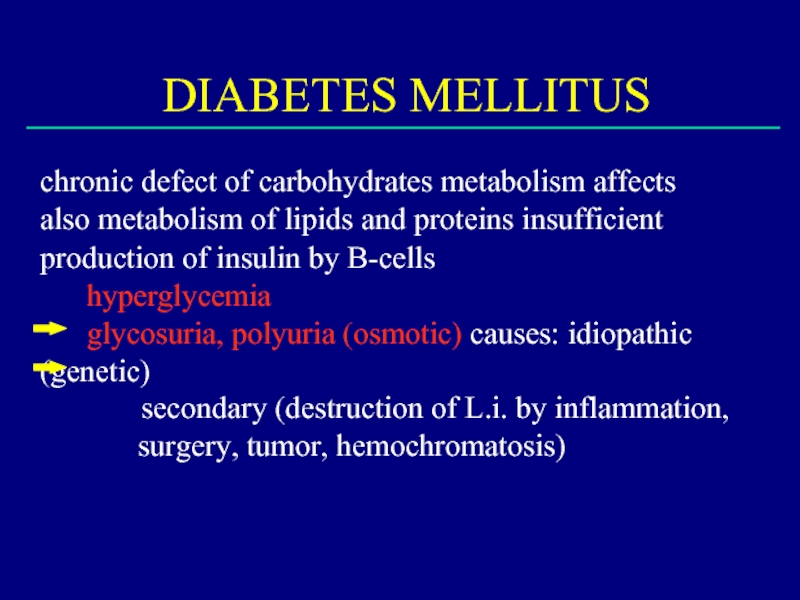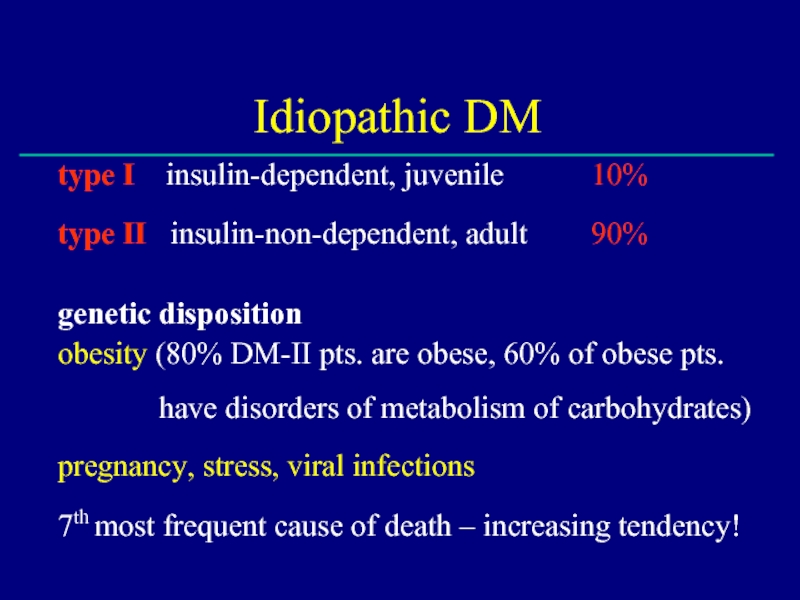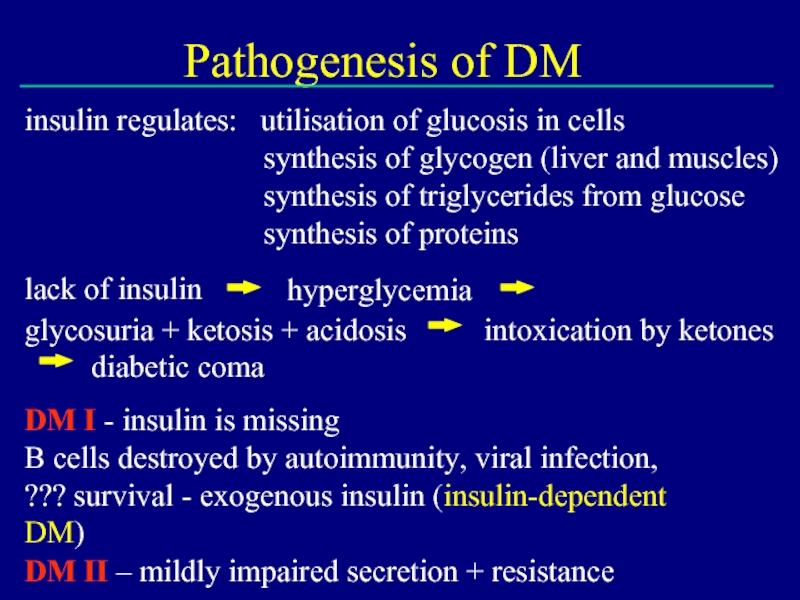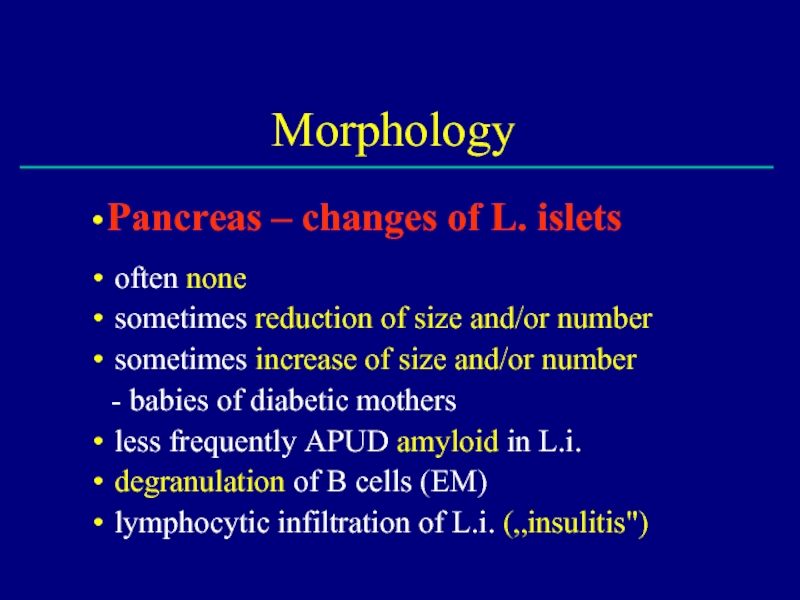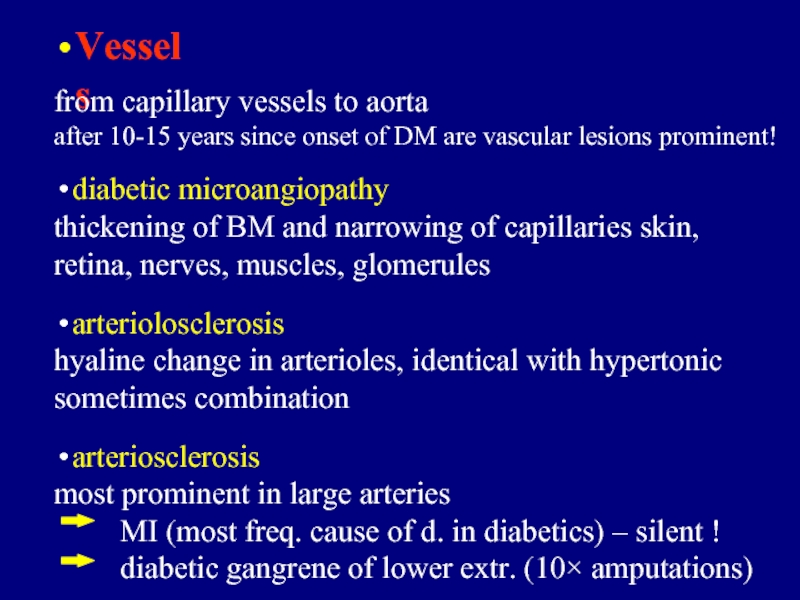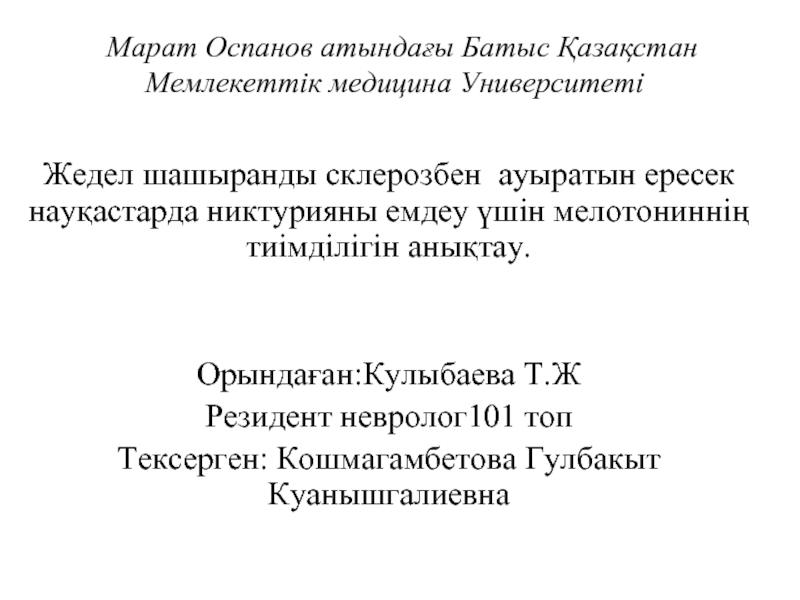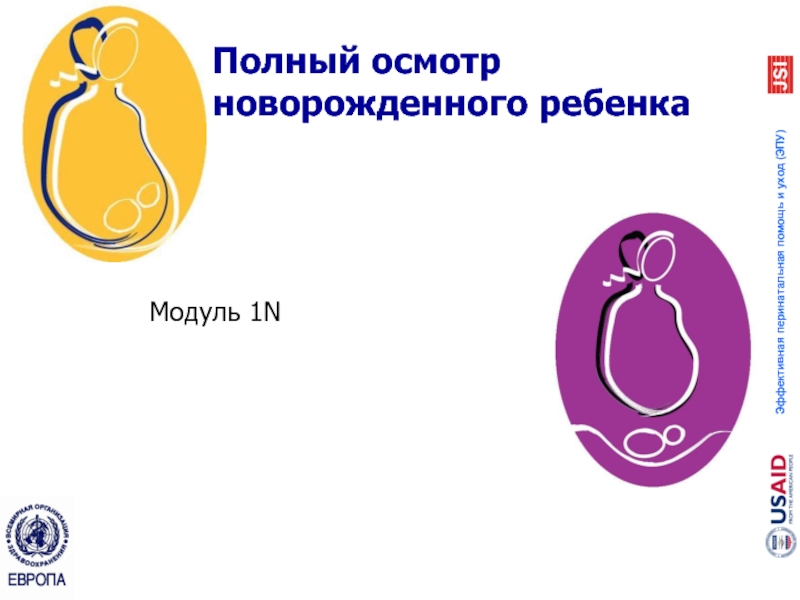- Главная
- Разное
- Дизайн
- Бизнес и предпринимательство
- Аналитика
- Образование
- Развлечения
- Красота и здоровье
- Финансы
- Государство
- Путешествия
- Спорт
- Недвижимость
- Армия
- Графика
- Культурология
- Еда и кулинария
- Лингвистика
- Английский язык
- Астрономия
- Алгебра
- Биология
- География
- Детские презентации
- Информатика
- История
- Литература
- Маркетинг
- Математика
- Медицина
- Менеджмент
- Музыка
- МХК
- Немецкий язык
- ОБЖ
- Обществознание
- Окружающий мир
- Педагогика
- Русский язык
- Технология
- Физика
- Философия
- Химия
- Шаблоны, картинки для презентаций
- Экология
- Экономика
- Юриспруденция
Endocrine pathology презентация
Содержание
- 1. Endocrine pathology
- 2. secretion of hormones (steroids, peptides) feedback inhibition
- 3. Adenohypophysis ventral lobe embryologically derived from mouth
- 4. Hyperpituitarism and adenomas of pituitary
- 5. majority of adenomas produce only 1 hormone
- 6. Hormonal syndromes prolactin oligo-, amenorrhea, galaktorrhea, impotence gigantism
- 7. Hypopituitarism loss of at least 75% of
- 8. pituitary nanism: decrease of GH substitution hypogonadism
- 9. Posterior lobe syndrome the cause
- 10. THYROID GLAND regulated by adenohypophysis
- 11. Thyroid gland - pathology more frequent in females
- 12. Hyperthyroidism diffuse hyperplasia of TG
- 13. Hyperthyroidism - clinical symptoms increase of basal
- 14. Hypothyroidism loss of parenchyma (resection, irradiation, medication) Hashimoto's thyroiditis idiopathic (autoimmune?) hypothyroidism
- 15. Hypothyroidism - clinical symptoms IN
- 16. THYROIDITIS Hashimoto's thyroiditis (= H.
- 17. Focal lymphocytic t. very frequent, in females
- 18. GRAVES - BASEDOW DISEASE = toxic goiter
- 19. GB goiter - histology "too much epithelium, too
- 20. GOITER this term doesn't say neither anything
- 21. Endemic goiter by iodine deficiency decreased synthesis
- 22. Nodular colloidal goiter weight 300g
- 23. TUMORS 80% of solitary nodules are adenomas
- 24. CARCINOMAS not frequent, up to 3 ×
- 25. Papillary carcinoma approx. 70% of all carcinomas
- 26. Follicular carcinoma about 20% of malignancies difficult
- 27. ADRENAL GLANDS 2 organs in 1 cortex
- 28. ADRENAL CORTEX spongiocytes producing steroid hormones glucocorticoids,
- 29. Cushing's sy - clinical symptoms obesity (so
- 30. Cushing's sy - causes pituitary adenoma –
- 31. Cushing's sy - morphology cortical adenoma high
- 32. Hyperaldosteronism mineralocorticoid aldosterone regulation through renin-angiotensin system
- 33. Adrenogenital syndrome adenoma, hyperplasia or carcinoma of
- 34. Hypofunction primary = insufficiency due to damage of cortex
- 35. Addison's disease •Morphology leaf-like adrenals (very thin
- 36. Tumors adenoma – majority non-functional, 1-2 cm
- 37. ADRENAL MEDULLA chromaffine cells producing epinephrine (adrenalin)
- 38. Pheochromocytoma production of adrenalin a noradrenalin 90%
- 39. Neuroblastoma highly malignant tumor of children aged
- 40. DIABETES MELLITUS chronic defect of carbohydrates metabolism
- 41. Idiopathic DM genetic disposition obesity (80% DM-II
- 42. Pathogenesis of DM insulin regulates: utilisation of
- 43. Morphology Pancreas – changes of L. islets
- 44. Vessels from capillary vessels to aorta after
Слайд 1Endocrine pathology
Lecture on pathomorphology
for 3-rd year students
ZAPOROZHZHIAN STATE MEDICAL UNIVERSITY
The
and forensic medicine
Слайд 2secretion of hormones (steroids, peptides)
feedback inhibition
blood
regulation of activity of various organs
ENDOCRINE SYSTEM
Слайд 3Adenohypophysis
ventral lobe embryologically derived
from mouth cavity
eosinophils (A cells) basophils
5 hormones:
ACTH TSH FSH+LH
prolactin GH
Слайд 5majority of adenomas produce only 1 hormone
up to 30% adenomas non-functional – only local pressure effect
„balloon“ expansion of
usuration
rupture of diaphragm + suprasellar growth
pressure to chiasma & n. opticus, impression of
brain & paranasal sinuses vision, headache
disturbances of
Pituitary adenomas
Слайд 6Hormonal syndromes
prolactin
oligo-, amenorrhea, galaktorrhea, impotence gigantism up to 240 cm acromegaly, macroglossy
hypertension etc. (see adrenal)
GH
ACTH
Слайд 7Hypopituitarism
loss of at least 75% of parenchyma due to:
nonfunctional adenoma (pressure atrophy)
ischemic
empty sella sy – following inflammation, operation,
irradiation herniation of arachnoid & CSF into the
sella
Слайд 8pituitary nanism: decrease of GH
substitution
hypogonadism (Fröhlich's sy = dystrophia adiposogenitalis) – accomp.
hypothyroidism
disorders of adrenal cortex
Hypopituitarism - clinical symptoms
Слайд 9
Posterior lobe syndrome
the cause is usually in hypothalamus, very rare decreased
Слайд 10 THYROID GLAND
regulated by adenohypophysis (TSH) and blood levels of
thyroglobulin in follicular colloid transformation to
thyroxine (T4) a triiodothyronine (T3)
parafollicular C cells
calcitonin – facilitates binding of
Ca2+ to bones and inhibits bone resorption
derived from pharyngeal epithelium – thyroglossal duct
persistence
thyroglossal duct cyst (median neck cyst)
lingual thyroid
Слайд 11Thyroid gland - pathology
more frequent in females (M:F = 1:10!)
namely enlargement -
increased secretion - hyperthyroidism, thyreotoxicosis
decreased secretion - hypothyroidism
hyperplasia, inflammations, tumors
Слайд 12 Hyperthyroidism
diffuse hyperplasia of TG (M. Graves-Basedow)
toxic nodular goiter
toxic adenoma
thyroiditis
pituitary
Слайд 13Hyperthyroidism - clinical symptoms
increase of basal metabolism, O2 consumption
restlessness, emotional lability
tremor,
intolerance of warmth
SOB, increased heart rate and output, palpitations congestive heart failure due to thyrotoxic cardiomyopathy (dilated type)
exophtalmus
Слайд 14Hypothyroidism
loss of parenchyma (resection, irradiation, medication)
Hashimoto's thyroiditis
idiopathic (autoimmune?) hypothyroidism
Слайд 15
Hypothyroidism - clinical symptoms
IN CHILDHOOD - cretinism
endemic iodine deficiency in mountain
short stature, big tongue, defective teeth,
rough facial features
IN ADULTHOOD - myxedema
accumulation of mucopolysacharides in corium thick (doughlike) skin, namely in periorbital areas
pale
bradycardia, apathy, intolerance of cold, big lips and tongue
enlarged and failing heart with pericardial fluid coronary arteriosclerosis due to hypercholesterolemia
Слайд 16 THYROIDITIS
Hashimoto's thyroiditis
(= H. goiter)
most frequent inflammation, autoimmune immune reaction against
Слайд 17Focal lymphocytic t.
very frequent, in females
usually only subclinical manifestation (increase of
normal T3, T4)
often incidental morphological finding
Subacute granulomatous t. (De Quervain's)
viral etiol.? - fever, palp. tenderness, pain, transitory hyperfunction
granulomas with multinucleated giant cells
heals spontaneously, not operated
Fibrous goiter (Riedel's)
firm idiopathic fibrosis of the gland, merging into surrounding structures, extremely rare
Слайд 18GRAVES - BASEDOW DISEASE
= toxic goiter
most frequent cause of hyperthyroidism (diffuse
triad:
hyperthyroidism
exophthalmia (in 2/3) - edema of retrobulbar connective tissue
("malignant" e. – not possible to close eyelids – corneal ulcers - blindness)
pretibial edema - (in 1/6) - mucin, lymphocytes
up to 7× more frequent in females
autoimmune mechanism (thyroid stimulating Ab., thyroid growth stimulating Ab.) – against TSH-receptors
Слайд 19GB goiter - histology
"too much epithelium, too few colloid"
epithelial cells tall, colloid pale,
(marginal usurations), stromal lymphoid infiltrates rich vascularization
Слайд 20GOITER
this term doesn't say neither anything about etiology
nor about the character
most often of hyperplastic origin
first diffuse, later on nodular
often accompanied by regressive changes
Слайд 21Endemic goiter
by iodine deficiency decreased synthesis of hormone compensatory increase of TSH enlargement
Sporadic goiter
multifactorial, i.e. iodine and goitrogenes in diet: cabbage,
cauliflower, turnip, kale
females, frequently onset in puberty or pregnancy
Слайд 22
Nodular colloidal goiter
weight 300g up to 1kg, sometimes retrosternal growth
histologically - nodules,
and/or calcifications
micro- normo- a macrofollicular (majority) - large follicles with colloid (colloidal goiter) eufunctional g., toxic g., hypofunctional g. cytology of cold nodes (diff. from carcinoma)
(suspicious goiters and g. with clin. symptoms are operated)
Слайд 23TUMORS
80% of solitary nodules are adenomas
benign, mainly solitary, spheric, encapsulated
follicular adenoma
normofollicular,
oncocytic adenoma
large eosinophillic cells
Слайд 24CARCINOMAS
not frequent, up to 3 × more often in females
post-irradiation- Hiroshima
therapeutic irradiation (lymphomas in
childhood)
from follicular cells
well differentiated - papillary, follicular, oncocytic
poorly differentiated - insular undifferentiated - anaplastic
from C cells
medullary
Слайд 25Papillary carcinoma
approx. 70% of all carcinomas
diagnostic feature is not presence of
sometimes only minute (mm) - microcarcinoma invasion into capsule, fibrosis
psammoma bodies (concentric calcifications) meta to LN, good prognosis - 80% 10y. survival
Слайд 26Follicular carcinoma
about 20% of malignancies
difficult diff. dg. vs. adenoma - invasion
capsule and/or vascular invasion!
meta to bones, lungs, brain
Anaplastic carcinoma
10% of malignancies, highly agressive
histologically – small cell, large cell, spindle cell type
death within 2 years
Medullary carcinoma
from C cells (calcitonin!), sometimes familial occurrence
solid foci of small cells, production of amyloid
(„APUD amyloid")
Слайд 27ADRENAL GLANDS
2 organs in 1 cortex vs. medulla
different embryogenesis different structure
Слайд 28ADRENAL CORTEX
spongiocytes producing steroid hormones glucocorticoids, mineralocorticoids, sex steroids hyperfunction, hypofunction,
Hyperfunction (hypercorticism)
steroids:
glucocorticoids (mainly cortisol)
Cushing's sy mineralocorticoids (mainly aldosterone)
hyperaldosteronism (Conn's sy)
androgens virilism (adrenogenital sy)
Слайд 29Cushing's sy - clinical symptoms
obesity (so called arachnoid type)
moon-face, neck hump,
hypertension, muscle weakness
osteoporosis, hirsutism and amenorrhea
impaired metabolism of glucose (steroid diabetes)
psychotic disorders
Слайд 30Cushing's sy - causes
pituitary adenoma – increase of ACTH hyperplasia of
functioning cortical adenoma
paraneoplastic sy - (in 10-15%) – increased ACTH
produced by tumor cells (most often small cell lung cancer)
hyperplasia of the cortex
iatrogenic – Cushing's sy caused by treatment (glucocorticoids - immunosupression atrophy of the cortex)
Слайд 31Cushing's sy - morphology
cortical adenoma
high level of cortisol causes hyaline degeneration
of
atrophy of the cortex
pituitary adenoma
hyperplasia of adrenal cortex - diffuse or nodular
bilateral
Слайд 32Hyperaldosteronism
mineralocorticoid aldosterone
regulation through renin-angiotensin system
increased excretion of K+ and retention of Na+
hypokalemia,
of extracellular fluid, blood hypertension
muscle weakness (including myocardium)
primary aldosteronism in cortical adenoma - Conn's sy
Слайд 33Adrenogenital syndrome
adenoma, hyperplasia or carcinoma of the cortex in young females
in young males pubertas praecox
Слайд 34Hypofunction
primary = insufficiency due to damage of cortex
(Addison's disease)
secondary = insufficiency due to
( decrease of ACTH)
Слайд 35Addison's disease
•Morphology
leaf-like adrenals (very thin cortex)
•Clinical symptoms
weakness, fatigue, skin and mucosa
hypoglycemia, hypotension diarrhea, loss of weight
stress may lead to acute crisis with coma (acute
cortical insufficiency)
massive bleeding into cortex (labor trauma, venous
thrombosis, meningoc. sepsis w. DIC –
Waterhause-Friderichsen sy)
Слайд 36Tumors
adenoma – majority non-functional, 1-2 cm incidental finding in US, CT
carcinoma – very rare, usually non-functional
myelolipoma - benign mesenchymal tumor
histology – similar to bone marrow
Слайд 37ADRENAL MEDULLA
chromaffine cells producing epinephrine (adrenalin) and norepinephrine (noradrenalin)
pathology of medulla:
Pheochromocytoma
Neuroblastoma
Слайд 38Pheochromocytoma
production of adrenalin a noradrenalin
90% from medulla, 10% from sympatic ganglia
(paraganglioma)
„tumor
10% extraadrenal
10% malignant
grams to kg!
histology:
polygonal cells, EM a immunocytoch.
neuroendocrine granules
permanent or paroxysmal hypertension
(tachycardia, sweating, headache)
clinically:
Слайд 39Neuroblastoma
highly malignant tumor of children aged 5 - 15 years from
related to retinoblastoma
frequent necroses, bleeding and intratumoral calcifications
(X-ray!), sometimes production of catecholamins
histology:
small cells, Homer-Wright rosettes
metastases to bones and liver
according to degree of differentiationneuroblastoma
ganglioneuroblastoma
ganglioneuroma
Слайд 40DIABETES MELLITUS
chronic defect of carbohydrates metabolism affects also metabolism of lipids
hyperglycemia
glycosuria, polyuria (osmotic) causes: idiopathic (genetic)
secondary (destruction of L.i. by inflammation, surgery, tumor, hemochromatosis)
Слайд 41Idiopathic DM
genetic disposition
obesity (80% DM-II pts. are obese, 60% of obese
pregnancy, stress, viral infections
7th most frequent cause of death – increasing tendency!
Слайд 42Pathogenesis of DM
insulin regulates:
utilisation of glucosis in cells
synthesis of glycogen (liver
hyperglycemia
lack of insulin
glycosuria + ketosis + acidosis diabetic coma
DM I - insulin is missing
intoxication by ketones
B cells destroyed by autoimmunity, viral infection, ??? survival - exogenous insulin (insulin-dependent DM)
DM II – mildly impaired secretion + resistance
of peripheral cells to insulin
Слайд 43Morphology
Pancreas – changes of L. islets
often none
sometimes reduction of size and/or
sometimes increase of size and/or number
- babies of diabetic mothers
less frequently APUD amyloid in L.i.
degranulation of B cells (EM)
lymphocytic infiltration of L.i. („insulitis")
Слайд 44Vessels
from capillary vessels to aorta
after 10-15 years since onset of DM
diabetic microangiopathy
thickening of BM and narrowing of capillaries skin, retina, nerves, muscles, glomerules
arteriolosclerosis
hyaline change in arterioles, identical with hypertonic
sometimes combination
arteriosclerosis
most prominent in large arteries
MI (most freq. cause of d. in diabetics) – silent !
diabetic gangrene of lower extr. (10× amputations)

